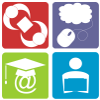Wiki History
Lesson Plan for PJ Olivier - Introducing HTML - 2012-07-25
Introduce the class, ask learners if they know what a computer is, if they can explain how one works as they might explain how a car or bicycle works. How is it that letters appear on the screen when typing on the keyboard? Ask if they know what the internet is, and the difference between the internet and the web. Hint at answers throughout course, learners should be able to answer definitively by end of course. Why would you want to know? Isn't complicated, esoteric and unnecessary for the ordinary person: The debate over whether the Net is good or bad for us fills the airwaves and the blogosphere. But for all the heat of claim and counter-claim, the argument is essentially beside the point: it’s here; it’s everywhere. The real question is, do we direct technology, or do we let ourselves be directed by it and those who have mastered it? “Choose the former,” writes Rushkoff, “and you gain access to the control panel of civilization. Choose the latter, and it could be the last real choice you get to make. http://www.rushkoff.com/program-or-be-programmed/
Introduce passage by Douglas Rushkoff, from Program or Be Programmed: In the long run, each media revolution offers people an entirely new perspective through which to relate to their world. Language led to shared learning, cumulative experience, and the possibility for progress. The alphabet led to accountability, abstract thinking, monotheism, and contractual law. The printing press and private reading led to a new experience of individuality, a personal relationship to God, the Protestant Reformation, human rights, and the Enlightenment. With the advent of a new medium, the status quo not only comes under scrutiny; it is revised and rewritten by those who have gained new access to the tools of its creation. Unfortunately, such access is usually limited to small elite. The Axial Age invention of the twenty-two-letter alphabet did not lead to a society of literate Israelite readers, but a society of hearers, who would gather in the town square to listen to the Torah scroll read to them by a rabbi. Yes, it was better than being ignorant slaves, but it was a result far short of the medium’s real potential. Likewise, the invention of the printing press in the Renaissance led not to a society of writers but one of readers; except for a few cases, access to the presses was reserved, by force, for the use of those already in power. Broadcast radio and television were really just extensions of the printing press: expensive, one-to-many media that promote the mass distribution of the stories and ideas of a small elite at the center. We don’t make TV; we watch it. Computers and networks finally offer us the ability to write. And we do write with them on our websites, blogs, and social networks. But the underlying capability of the computer era is actually programming—which almost none of us knows how to do. We simply use the programs that have been made for us, and enter our text in the appropriate box on the screen. We teach kids how to use software to write, but not how to write software. This means they have access to the capabilities given to them by others, but not the power to determine the value-creating capabilities of these technologies for themselves. Like the participants of media revolutions before our own, we have embraced the new technologies and literacies of our age without actually learning how they work and work on us. And so we, too, remain one step behind the capability actually being offered us. Only an elite—sometimes a new elite, but an elite nonetheless—gains the ability to fully exploit the new medium on offer. The rest learn to be satisfied with gaining the ability offered by the last new medium. The people hear while the rabbis read; the people read while those with access to the printing press write; today we write, while our techno-elite programs. As a result, most of society remains one full dimensional leap of awareness and capability behind the few who manage to monopolize access to the real power of any media age. And this time, the stakes are actually even higher. Program or be Programmed - Douglas Rushkoff, OR Books New York, 2010 The objective for the rest of this lesson is to call attention to hidden systems of meaning and the world of information which surrounds us. This will then be extended in the next lesson to those systems used to encode information in markup and computer languages. Who is the message for, what does it say, why bother sending it?
- Manufacture dots on bottles and glass jars: Produce a bottle, call attention to the pattern of dots on the base. Ask if anyone knows what they are or what they mean. While they think about that point out:
- UV patterns on flowers: Show UV photographs of flowers - message from the flower to pollinating insects which see in UV, but not to us, who cannot. Gallery of exmples
- Red color of fruits: Most mammals cannot see red, humans and other fruit-eating primates can in order to pick up on signals sent by plants to indicate ripe fruits, a signal sent to allow plants to disperse seeds.
- EURion constellation: anti-counterfeiting device recognised by photocopiers, etc.
- Mating songs of mice: mice sing to attract mates in a higher register than humans can hear, maybe make a joke here about Disney films with singing mice telegraph article.
   
Return to the bottle. Why does almost every bottle and jar in the world have a pattern on the base that nobody knows how to read? Who is the message for? Why is it so important that all this effort is spent? Have learners ever noticed these dots before? Why not?
Each learner to find three other hidden systems of meaning for next class (barcodes, pheromones, printer steganography, whalesong, etc). Add them to awareNet project on Semiotics.
|
|
This Revision 
 |
| by: |
Richard Strickland |
| on: |
2012-07-25 10:03:53 |
| for: |
Spelling and grammar |
[show revision >>]
|
|

